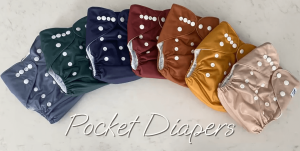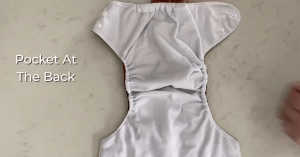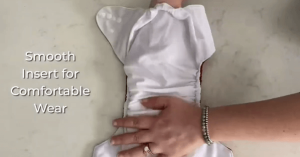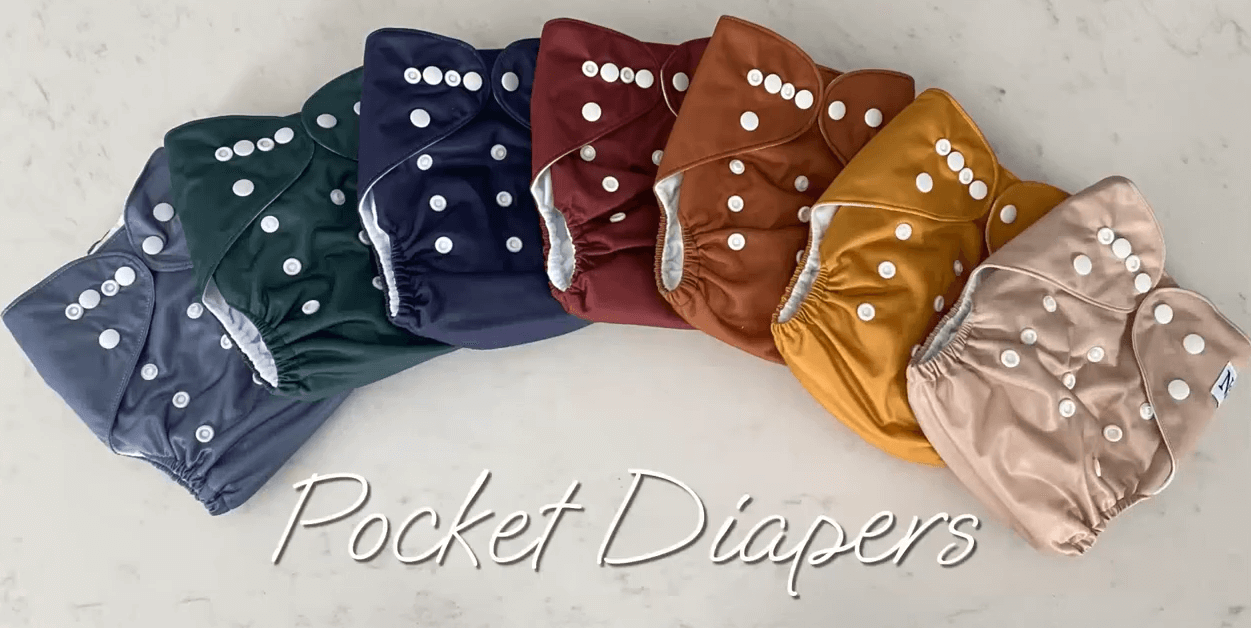What are Pocket Cloth Diapers: The Beginner’s Guide (2023)

Pocket cloth diapers represent a modern and convenient approach to diapering for parents who prefer eco-friendly alternatives to disposable diapers. Pocket diapers are a more straightforward and user-friendly option when compared to traditional cloth diapers that need to be folded and pinned.
With their ease of use, effective containment of messes, and options for personalization, pocket cloth diapers have gained popularity among parents looking for a reliable and environmentally conscious diapering choice for their babies.
This exploration will delve deeper into what are pocket cloth diapers ?, how they work, and why they have become a favored choice in modern parenting.
What are pocket cloth diapers?

A cloth pocket diaper is a popular type of cloth diapering system known for its ease of use and effective absorbency. Two layers make up this jacket: an outer waterproof layer and an inner stay-dry layer with a pocket in between.
The diaper is typically shaped like a disposable diaper, featuring elastic waist and leg openings for a secure fit and convenient fastener, such as snaps or Velcro, for easy adjustments around the waist. Pocket diapers can come in various sizes or as one-size-fits-all options to accommodate babies of different ages and sizes.
What Materials Are Used in Pocket cloth diapers?
Pocket diapers have revolutionized the world of modern parenting with their eco-friendly, cost-effective, and highly customizable approach to diapering. These innovative cloth diapers have two main components: an outer waterproof layer and an inner stay-dry layer, with a pocket cleverly nestled in between. The magic of pocket diapers lies in their ability to provide tailored absorbency by inserting various types of absorbent materials into the bag.
The Outer Layer: PUL Fabric
At the heart of every pocket diaper is the outer layer, crafted from a material known as PUL (Polyurethane Laminate) fabric. It protects your child from leaks and moisture with its ingenious fabric. PUL fabric is a cloth skillfully coated with a thin plastic laminate, rendering it waterproof. This waterproof barrier ensures your baby stays dry, preventing unwanted leaks from escaping the diaper. PUL fabric comes in various colors and patterns, adding a touch of style to your baby’s wardrobe while performing its vital function effectively.
The Inner Layer: Polyester Microfleece
Moving inward, we encounter the pocket diaper’s inner layer, typically made from polyester microfleece. This inner lining is crucial in keeping your baby comfortable and rash-free. While it’s generally advised not to let polyester come in direct contact with your baby’s delicate skin, microfleece is an exception. It is safe, exceptionally soft, and comfortable for your little one. Moreover, microfleece possesses excellent moisture-wicking properties, ensuring that wetness is drawn away from your baby’s skin and into the absorbent inserts, thus minimizing the risk of diaper rashes.
The Inserts: Varied and Versatile

The heart of the pocket diaper’s absorbency lies in its inserts. In addition to keeping your baby dry and comfortable, these inserts soak up moisture. Pocket diapers offer the flexibility of choosing from various insert materials, each with its unique set of advantages:
- Microfiber Inserts
Microfiber is a popular choice for pocket cloth diaper inserts. However, it’s essential to note that Microfiber should not be placed directly against your baby’s skin as it can dry. Fortunately, in pocket diapers, the microfiber insert is tucked safely inside the pocket, ensuring it doesn’t come into direct contact with your baby’s delicate skin. Microfiber is known for its rapid absorption, making it an excellent choice for handling heavy wetting.
- Bamboo Inserts
Bamboo cloth diaper inserts have become incredibly popular among parents for various reasons.. First and foremost, bamboo fabric is incredibly soft, making it gentle on your baby’s skin. Additionally, it’s naturally hypoallergenic, minimizing the chances of irritation or allergies. Moreover, even after multiple washes, bamboo maintains its softness, ensuring enduring comfort for your child. Opting for bamboo inserts is an excellent decision for parents who place a high value on both comfort and absorbency.
- Hemp Inserts
Hemp cloth diaper inserts take the lead when it comes to overnight protection and maximum absorbency. Hemp is known for its exceptional ability to absorb moisture, making it ideal for extended wear, such as overnight diapering. Additionally, hemp is an all-natural material that appeals to eco-conscious parents. While hemp inserts may be slightly bulkier than other options, they offer unparalleled absorbency, making them an excellent choice for heavy wetters.
Benefits of Pocket Cloth Diapers
Ease of Use: Pocket diapers are simple to use without complex folding, thanks to adjustable snaps for babies weighing 8 to 35 pounds.
Customizable Absorbency: These diapers allow customization by adding various inserts for different absorbency needs, making them great for nighttime use.
Mix and Match Inserts: Flexibility lets you choose any absorbent insert you prefer, from prefolds to old blankets or cotton t-shirts.
Quick Drying: Pocket diapers have separate parts and dry faster than all-in-one cloth diapers.
Versatile: Ideal for various situations, including use by babysitters, overnight wear, reusing pocket covers, and even using disposable inserts for travel.
Downsides of Pocket Cloth Diapers
Stuffing: Inserting absorbent materials into pockets can be an extra step in the diaper-changing routine, which some parents may find tedious.
Limited Overnight Use: Pocket diapers have limitations for overnight use due to potential leaks if overfilled.
Higher Upfront Cost: They may have a higher initial cost than other cloth diaper options, although they can be cost-effective in the long run.
Longer Drying Time: Inserts in pocket diapers can take longer to dry, requiring a sufficient supply for a smooth routine.
Sizing-Up: Some pocket diapers may require sizing up as your baby grows, potentially leading to additional expenses.
Pre-Stuffing: Many parents prefer pre-stuffing pocket diapers for convenience, which adds an extra step to laundry routines.
When should you choose pocket cloth diapers?
Choosing pocket cloth diapers is an excellent decision when convenience and ease of use are top priorities. These diapers are particularly well-suited for parents new to cloth diapering and looking for a straightforward solution. With their user-friendly design that resembles disposable diapers, pocket cloth diapers make the transition to cloth diapering smooth.
Additionally, if customization options and the ability to use them for nighttime comfort are essential, pocket cloth diapers offer the flexibility to meet these needs effectively.
How to Use Pocket Cloth Diapers?
Using pocket cloth diapers is a hassle-free process, beginning with the time-saving practice of preassembly, where the diaper’s pocket is stuffed with an absorbent insert in advance. Fastening these diapers is a breeze, with snap or Velcro closures akin to disposable diapers. When it’s time for cleanup, addressing soiled areas, mainly if there’s poop, can be facilitated by a diaper sprayer or scraper.
Remember to extract the insert before washing to ensure thorough cleaning and diaper integrity. Maintaining these diapers involves using approved cloth diaper detergent and allowing them to air dry, preferably in the sunshine. This straightforward approach and proper care make pocket cloth diapers a convenient and eco-conscious choice for parents seeking simplicity.
All-in-Ones vs. pocket cloth diapers
| Aspect | All-in-One cloth Diapers | Pocket cloth Diapers |
| Ease of Use | Very easy, as everything is preassembled. | Relatively easy but requires preassembly. |
| Absorbency Adjustment | May require additional absorbency layers. | Customizable absorbency with inserts. |
| Cost Efficiency | Expensive upfront but convenient. | Less expensive upfront and can save money. |
| Price Range | Generally pricier, ranging from $15-$40. | Typically range from $15-$40, similar to AIO. |
| Additional Supplies | May need extra layers, increasing cost. | Inserts included, can use them multiple times. |
| Travel and Daycare | Convenient for on-the-go and daycare. | Equally suitable for travel and daycare. |
How Much Do Pocket Cloth Diapers Cost?
The cost of pocket cloth diapers can fluctuate based on the brand, quality, and source of purchase. On average, pocket diapers typically range from $15 to $30 per diaper. However, it’s important to note that this is just the initial upfront cost, and over time, using pocket cloth diapers can prove to be more cost-effective than disposable diapers. Some pocket diapers come with multiple inserts, allowing you to use each diaper numerous times, increasing their value for money.
FAQs
Q-1 How many pocket cloth diapers do I need?
A good starting point for cloth diapers is to have 2-3 days’ worth in your stash. The recommended minimum quantity varies based on your baby’s age: 36 for newborns, 24 for infants, and 20 for toddlers. However, these figures can fluctuate based on the child and the day’s unique circumstances.
Q-2 What is the difference between pocket diapers and diaper covers?
The critical distinction between a pocket diaper shell and a cloth diaper cover is a simple lining. This lining is sewn into pocket diapers but is absent in diaper covers.
The critical distinction between a pocket diaper shell and a cloth diaper cover is a simple lining. This lining is sewn into pocket diapers but is absent in diaper covers.
People prefer pocket diapers for their quick drying time and user-friendly design, providing efficient cleaning and convenience in diapering.
Q-4 Do you change pocket cloth diapers every time?
Yes, pocket diapers typically require a full change with every diaper change, including both the pocket diaper and the insert.
Q-5 How long do pocket cloth diapers last?
Pocket diapers generally have a life expectancy of 2-6 years, depending on usage, care, and quality factors.
Q-6 How many pocket cloth diapers do you need for one day?
On average, for infants (6-12 months old), having 6-10 cloth diapers per day is recommended, while toddlers (12-24 months) may require 4-7 diaper changes daily. However, these numbers can vary depending on the child and the specific day’s circumstances.
Q-7 How many pocket cloth diaper inserts do you need?
When using a system with reusable covers, target a direct 3:1 ratio of inserts to surfaces. It translates to having three clean pocket cloth diaper inserts for everybody. For instance, if you need 24 diaper changes, ensure you have 8-10 diaper covers and 24 inserts to meet your requirements effectively.
Q-8 What is a one-size pocket cloth diaper?
One-size diapers are adjustable to fit babies ranging from 8 to 40 lbs, offering convenience as your child grows. Soiled inserts can stay in the diaper and will agitate out during washing. The newborn insert comprises three layers of Microfiber, and the full-size insert features five layers of hemp/organic cotton. The stay-dry microfleece liner helps keep the baby dry.
Q-9 How to wash pocket cloth diapers?
Place the diapers in the washing machine (you can even include your regular clothes) and use warm water (104°F/40°C) along with cloth diaper-friendly detergent, avoiding fabric softeners. Afterward, you can dry the diapers on a low setting in a tumble dryer or hang them on a drying line.
So, What are pocket cloth diapers?
pocket cloth diapers offer a versatile and user-friendly diapering solution for parents. Their customizable fit, ease of use, and efficient cleaning process make them popular among new and experienced cloth diaper users. Although they may demand an initial investment, their long-term cost savings and convenience typically surpass the upfront expenses.
Additionally, the ability to adapt absorbency levels and their quick drying time further enhance their appeal. Whether you want to minimize your environmental impact, save money, or prioritize convenience, pocket cloth diapers are a reliable and sustainable choice for your baby’s diapering needs.
Also read
best pocket cloth diapers

